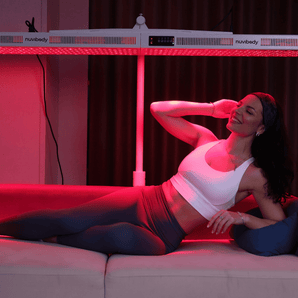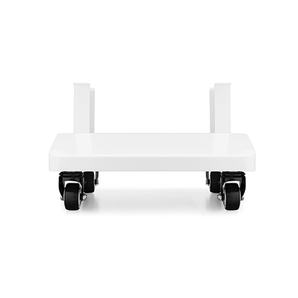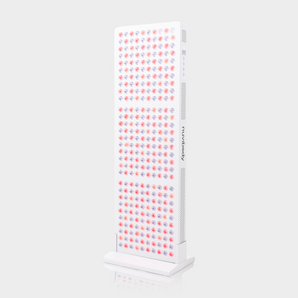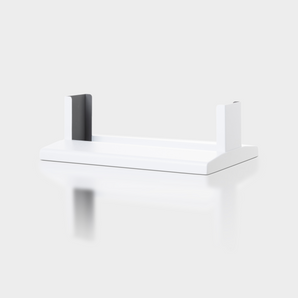Are you concerned about the safety of red light therapy for home use? That’s understandable! In this blog, we’ll take you through the safety profile of this popular therapy. We’ll discuss potential side effects, contraindications, and essential precautions to ensure you can safely use red light therapy. Always consult your doctor before starting any new treatment, especially if you have any health conditions.
Safety from Sunlight
A fundamental question when considering the safety of red light therapy often concerns our tolerance to sunlight. If you can tolerate moderate sunlight exposure for about 20 minutes without adverse effects, chances are good that you can safely benefit from LED red and near infrared (NIR) light therapy. Since approximately 42% of sunlight is made up of Red and NIR light, our bodies have adapted to absorb and benefit from these wavelengths.
While excessive exposure to UV or Blue Light in sunlight carries risks such as burning, the safety profile for Red and Near Infrared light is distinct. Red light therapy within the range of 600nm to 1100nm allows us to reap the health benefits of sunlight without the potential damage caused by UV rays.
Possible Contraindications
Various articles and sources outline specific contraindications for red light therapy. In the event that one or more of these contraindications are relevant to you, it is essential to evaluate this on a case-by-case basis in consultation with a medical professional.
Eye exposure: Direct exposure of the eyes to red light or near infrared light should be avoided as this may cause retinal damage. Keeping the eyes closed or wearing protective glasses is essential to protect the eyes during treatment.
Cancer: Red light therapy is used to enhance the proliferation (multiplication) of cells in a wound. Stimulating cell division could theoretically accelerate the growth or spread of cancer cells. There is some research suggesting that red light therapy can be used safely in tissues that contain cancer, but this research is inconclusive. This 2018 review article by Dr. Hamblin discusses the many complexities of this topic.
No one should use red light therapy on cancerous tissue without the oncologist's permission.
Pregnancy: Pregnant women are advised to exercise caution, especially when exposing the abdominal area to the therapy. Although research shows that red light is not directly harmful to the fetus, caution is advised due to limited studies on this topic.
Thyroid Problems: Increased stimulation of the thyroid gland can worsen symptoms caused by an already overactive thyroid gland. People with hyperthyroidism should not use red lights that can reach the thyroid gland without permission from their endocrinologist.
Epilepsy: People with epilepsy may be at risk of seizures when using red light therapy, especially if poor quality red light panels are used. Inherent to almost any light source is a phenomenon called flicker. Flicker can be invisible to the eye, but causes rapid fluctuations in the intensity of the light. People with epilepsy may be sensitive to flicker in red light panels and may experience a seizure if the flicker is severe or they are particularly sensitive to it. At Nuvibody, we use flicker-free drives to eliminate flicker from our panels.
Medications: Some medications can increase sensitivity to light. As a result, red light therapy may irritate the skin or cause a rash when red light therapy is used. Although red light therapy is unlikely to have a significant effect on people taking photosensitizing medications, it is best to check whether any medications you are taking can increase your sensitivity to light and to talk to a doctor before using red light therapy if you are taking any of these medications.
Male Genitals: Although red light therapy is generally considered safe for treatments on the testicles (in men), caution should be exercised with excessively high doses.
Active Bleeding: In active bleeding, exposure to red light is not recommended due to the potential to increase blood flow and thereby worsen bleeding.
Skin, Tattoos and Hair: Individuals with dark skin, tattoos or excessive hair growth in treated areas should be aware of a higher absorption of light, which may cause discomfort, pain or even skin damage. Dosage and intensity should be adjusted for these individuals to avoid side effects.
By understanding these specific contraindications and evaluating them individually in consultation with a medical professional, one can minimize the risks and maximize the safety of red light therapy.
Skin and Thermal Effects: While red light therapy is generally safe, exceeding specific skin temperatures for extended periods of time can lead to side effects such as skin redness, hyperpigmentation, and heat-related issues. Moderation in intensity and dosage is key to preventing these skin-related side effects. Follow the manufacturer’s directions for use.
Studies on red light therapy rarely report side effects; however, some people with sensitive skin have reported temporary skin redness or discomfort after treatment. Responsible use, including reduced intensity and duration, can help alleviate such reactions.
Conclusion
Humans have adapted to the intensity of the sun in such a way that they can withstand red and NIR light. In fact, it seems that we need some degree of absorption of red and NIR to live healthy and optimally, which is why photobiomodulation is such an important topic in clinical studies.
For the safety of our eyes, we have blink/deviation reactions, eye sockets, eyebrows, eyelashes, and eyelids to protect us from the sun. And even our genitals have hair and are positioned to protect them from direct sunlight.
If we ignore our nature and stare at the sun, that is the problem. If we ignore our senses that our skin feels intense heat, that is also a problem. The same goes for red and NIR. If we are mindful of the intensity and apply some common sense safety techniques, most people should not experience any negative reactions.
Several of the documented contraindications such as eyes, thyroid, gonads - the dangerous effects come from direct exposure and high intensities and dosages. There is promising research that shows that low intensity light can be beneficial to these areas when applied properly.
Other contraindications such as Cancer and Pregnancy are clearly precautionary and should be assessed on a case-by-case basis in collaboration with a physician.
And as a final note, we often see people unfairly accuse near infrared of dangers to the eyes, testicles, hyperpigmentation, etc. But in reality, we see many studies that have used red light to cause similar side effects and dangers - and conversely, NIR can help improve these areas when used properly.
So ultimately the safety profile for red and NIR (600nm-1100nm) light is highly dose dependent and not necessarily a particular wavelength within this range.
With these precautions in mind, moderate intensities and responsible use of red and NIR LEDs can be very safe for most people.
Disclaimer
Before beginning any therapy, including red light therapy, always seek professional medical advice. This blog is for educational purposes only and is not intended as a substitute for medical advice or consultation.
Sources:
- Barolet D, Christiaens F, Hamblin MR. Infrared and skin: Friend or foe. J Photochem Photobiol B . 2016;155:78-85. doi:10.1016/j.jphotobiol.2015.12.014 - https://www.ncbi.nlm.nih.gov/pmc/articles/PMC4745411/#R16
- Navratil L, Kymplova J. Contraindications in noninvasive laser therapy: truth and fiction. J Clin Laser Med Surg. 2002 Dec;20(6):341-3. doi: 10.1089/104454702320901134. PMID: 12513921.
- Godbold, John & Riegel, Ronald. (2017). Contraindications, Special Considerations, and Precautions: Photobiomodulation. 10.1002/9781119220190.ch7. - https://www.researchgate.net/publication/315648886_Contraindications_Special_Considerations_and_Precautions_Photobiomodulation/citation/download
- What are the PBM Therapy contraindications? THOR Photomedicine Ltd - https://www.thorlaser.com/LLLT/contraindications.htm
- Jagdeo J, Nguyen JK, Ho D, Wang EB, Austin E, Mamalis A, Kaur R, Kraeva E, Schulman JM, Li CS, Hwang ST, Wun T, Maverakis E, Isseroff RR. Safety of light emitting diode-red light on human skin: Two randomized controlled trials. J Biophotonics. 2020 Mar;13(3):e201960014. doi: 10.1002/jbio.201960014. Epub 2019 Dec 8. PMID: 31483941.
- Health Canada - skin safety - https://www.canada.ca/en/health-canada/services/drugs-health-products/medical-devices/activities/announcements/notice-risk-thermal-harm-therapeutic-medical- lasers-intense-pulsed-light-emitting-diodes.html
- Lee JH, Roh MR, Lee KH. Effects of infrared radiation on skin photo-aging and pigmentation. Yonsei Med J . 2006;47(4):485-490. doi:10.3349/ymj.2006.47.4.485
- Evaluation of subject response following treatment for pigmentation or wrinkles using a diode laser - https://doi.org/10.1111/jocd.13200
- Lee YI, Lee E, Nam KH, et al. The Use of a Light-Emitting Diode Device for Neck Rejuvenation and Its Safety on Thyroid Glands. J Clin Med . 2021;10(8):1774. Published 2021 Apr 19. doi:10.3390/jcm10081774
- Ahn, J.-C & Kim, Y.-H & Rhee, C.-K. (2013). The effects of low level laser therapy (LLLT) on the testis in elevating serum testosterone level in rats. Biomedical Research (India). 24. 28-32.
- Zhao J, Tian Y, Nie J, Xu J, Liu D. Red light and the sleep quality and endurance performance of Chinese female basketball players. - https://www.ncbi.nlm.nih.gov/pmc/articles/PMC3499892/
- Odinokov D, Hamblin MR. Aging of lymphoid organs: Can photobiomodulation reverse age-associated thymic involution via stimulation of extrapineal melatonin synthesis and bone marrow stem cells? J Biophotonics. 2018 Aug;11(8):e201700282. doi: 10.1002/jbio.201700282. Epub 2018 Feb 12. PMID: 29227581; PMCID: PMC5995606.
- Laakso, E-Liisa, and Tatjana Ewais. “A Holistic Perspective on How Photobiomodulation May Influence Fatigue, Pain, and Depression in Inflammatory Bowel Disease: Beyond Molecular Mechanisms.” - https://www.ncbi.nlm.nih.gov/pmc/articles/PMC10216148/
- Medications and other Agents that Increase Sensitivity to Light. https://www.dhs.wisconsin.gov/radiation/medications.htm





















